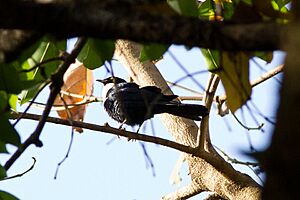White-collared starling facts for kids
Quick facts for kids White-collared starling |
|
|---|---|
 |
|
| male perched in a tree. | |
| Conservation status | |
| Scientific classification | |
| Genus: |
Grafisia
|
| Species: |
torquata
|
The white-collared starling (Grafisia torquata) is a cool type of starling bird. It belongs to the Sturnidae family, which includes many different kinds of starlings. This bird is the only species in its group, called Grafisia. You can find these special birds in countries like Cameroon, the Central African Republic, Chad, the Democratic Republic of the Congo, and Gabon in Africa.
Contents
How It Got Its Name
This bird was first discovered by a scientist named Anton Reichenow. He named it Spreo torquatus. The word "torquatus" comes from Latin and means "wearing a necklace." This name describes the white color around the male bird's neck.
Later, another scientist, James Chapin, also found this bird in 1913. He gave it a different name, Stilbopsar leucothorax. This name comes from Greek words meaning "white" and "chest," again pointing to its white collar.
Finally, in 1926, George Latimer Bates put this bird into its own group, Grafisia. He noticed that it was quite different from other starlings it had been grouped with before.
What It Looks Like
White-collared starlings look different depending on if they are male or female. This is called sexual dimorphism. They also differ in size and color.
Male and Female Differences
Adult male white-collared starlings are mostly shiny black. They have a bright white patch on their chest that reaches up to their wings. Their beak and legs are black, and their eyes are a bright yellow.
Adult female starlings are mostly grey. Their wing and tail feathers have black tips. The feathers on their head and back have blue-black tips.
Young Birds
Young starlings, called juveniles, and subadults look more like the female birds. However, their belly feathers are usually a brownish-grey color.
Sounds They Make
People have heard white-collared starlings make different sounds. They have a "chirruping" sound. They also have a call that sounds like three short whistles.
Where They Live and What They Do
White-collared starlings usually live in open woodlands. They seem to prefer staying high up in tall trees. They have also been seen in mountain grasslands in Cameroon.
What They Eat
These birds enjoy eating different kinds of food. They are known to eat insects and berries. They also like wild figs and the fruits from musanga and macaranga trees.
How They Live Together
White-collared starlings often travel in pairs or small groups. These groups usually have about 4 to 10 birds. In one special case, a very large group of more than 100 birds was seen in June.
Reproduction and Life Cycle
Scientists have observed these birds building nests in March. Males collected around this time had signs that they were ready to breed. Young birds have been seen between May and July. This suggests that white-collared starlings usually breed in the first half of the year.
In one instance, a male bird was seen flying in short circles from a high branch. This was thought to be a special dance to attract a mate.


